Recent Articles
Popular Makes
Body Types
2022 Chevrolet Malibu vs. 2022 Toyota Camry
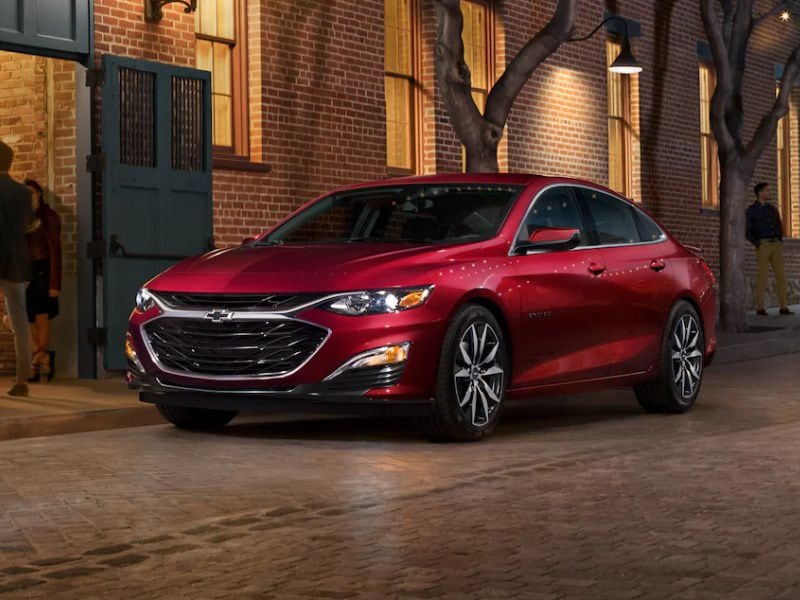
2022 Chevrolet Malibu ・ Photo by Chevrolet
The competition between the Chevrolet Malibu and the Toyota Camry is a battle between two of the most popular nameplates to inhabit the American car market. With its origins way back in the 1960s, the Chevy Malibu was a hot-selling mid-size car for decades. The Toyota Camry made its debut later, but it also quickly ascended to a place on the list of the top 10 bestsellers. Both the Malibu and the Camry are mid-size five-passenger sedans, and though many families are opting for crossovers instead of sedans these days, there is a lot to like about the ride comfort and handling of these well-engineered four-doors. Both have stood the test of time and offer a variety of modern features. If you seek solid, reliable transportation for years to come, the Chevrolet Malibu and Toyota Camry are great places to turn.
Exterior Design
In the context of today’s U.S. auto market, mid-size four-door sedans like the Toyota Camry and Chevrolet Malibu are pretty big vehicles. Both the Malibu and Camry are about 193 inches long, and they ride on wheelbases that are within 0.2-inch of one another at around 111 inches. Both are front-drive unibody platforms with transverse engines, so both cars offer plenty of space for five passengers. The exterior styling of both the Camry and Malibu are attractive but conservative, though the Camry does offer more “expressive” styling in some of its sporty variants. The Malibu’s bow to sportiness comes in its RS trim. The Malibu base model has 16-inch alloy wheels while the Camry has 17-inch alloys. From a dimensional and functional point of view, the Camry and Malibu are almost identical.
: Chevrolet Malibu
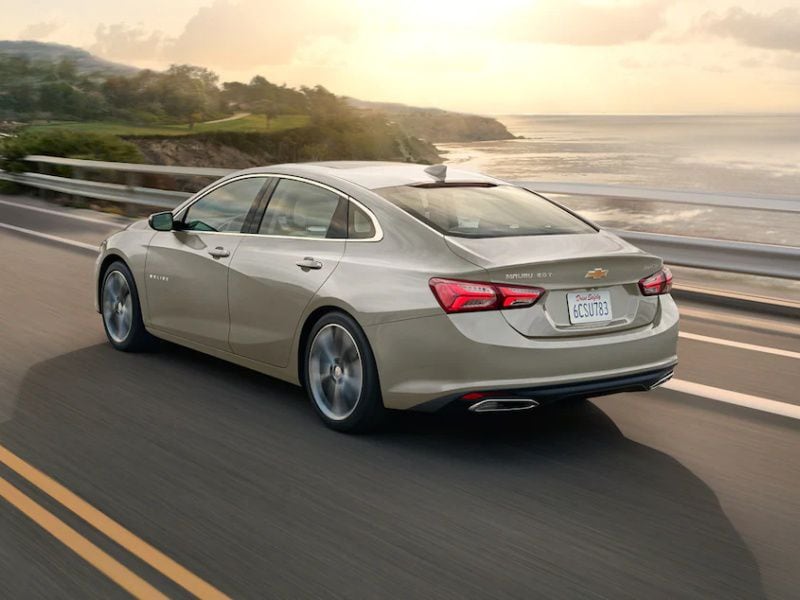
Photo by Chevrolet
Interior Style
Both Chevrolet Malibu and Toyota Camry have interiors that are functional and attractive. Since price is definitely an object with buyers of both cars, their designers have balanced luxury versus cost. In the middle trims that are the sweet spots of both vehicles, their interiors lack luxurious appointments and have a lot of plastic pieces, but they are still good-looking. In the top-of-the-line Malibu Premier, buyers will find premium-looking soft-touch materials and available leather seats. But, as with the Camry, many of the trims are fitted with cloth seats instead of leatherette or leather seat coverings. On the other hand, models like the Camry XSE offer standard leather front seats, 8-way power-adjustable driver's seat with power lumbar support, and 8-way power-adjustable front passenger seat. Overall, the Camry offers more interior choices and the opportunity to add more luxury features than the Malibu.
: Toyota Camry
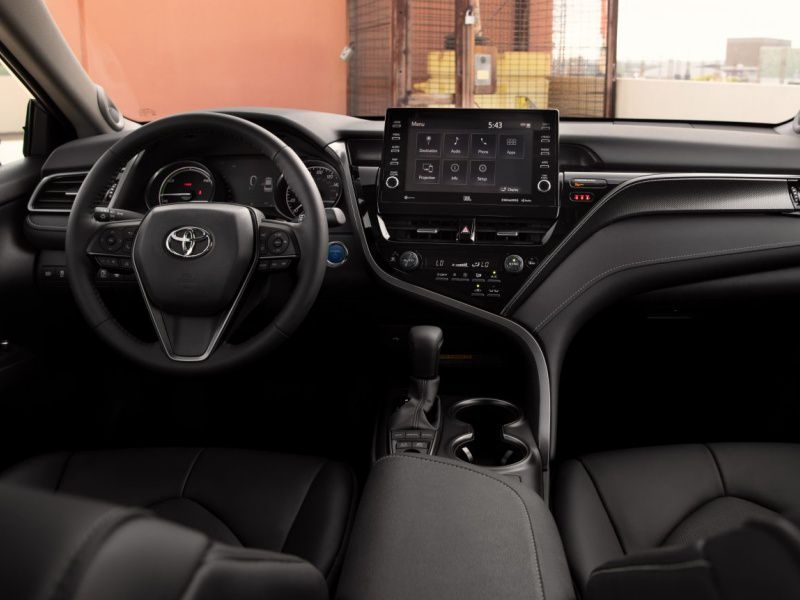
Photo by Toyota
Infotainment & Technology
Both the Toyota Camry and Chevrolet Malibu offer full-featured, easy-to-use infotainment systems. The 2022 Toyota Camry’s standard infotainment system has a 7-inch touchscreen with Android Auto, Apple CarPlay, and Amazon Alexa compatibility. Higher grades are fitted with a 9-inch touchscreen. The top-of-the-line infotainment system has a 9-inch screen, integral navigation, and nine JBL speakers including a subwoofer and amplifier. The Malibu infotainment system is accessed through an 8-inch color touchscreen with large, easy-to-see icons. One big plus for the Chevy is the fact that all Malibus have wireless Apple CarPlay and wireless Android Auto. A built-in Wi-Fi hotspot with available 4G LTE data is standard as well. The Malibu Premier has integral navigation and wireless device charging. Most Malibus have a 6-speaker audio system while the Premier has a 9-speaker Bose premium audio system.
: Chevrolet Malibu
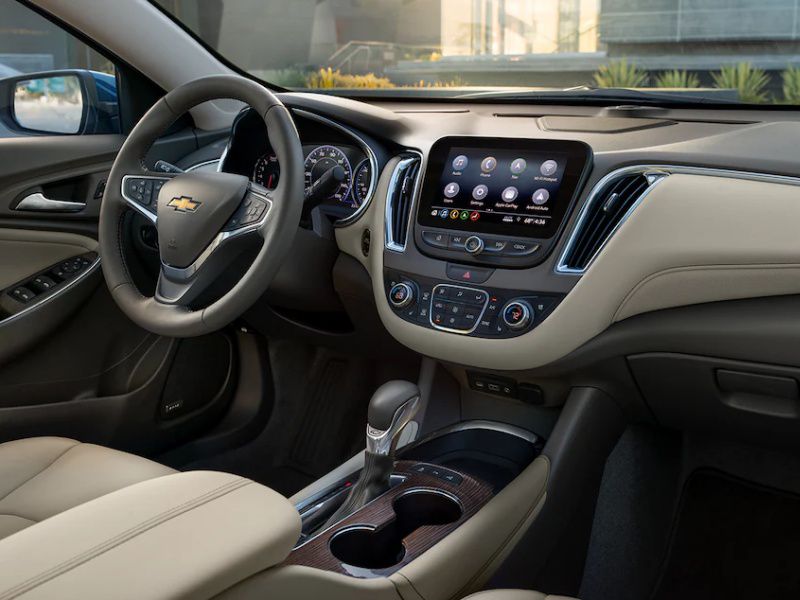
Photo by Chevrolet
Powertrains
If the two vehicles sound remarkably similar up to now, you’re not missing anything. But there are a few individual wrinkles when powertrains are considered. The Toyota Camry offers a naturally aspirated 4-cylinder engine as the base powerplant and a naturally aspirated V-6 or a hybrid powertrain as alternative upgrades. A 2.5-liter 4-cylinder engine is used across a wide variety of Camry trims, offering anywhere from 203 horsepower to 206 horsepower depending upon the application. A 301-horsepower 3.5-liter naturally aspirated V-6 is featured in higher trim levels. Both engines use an 8-speed automatic transmission, and all-wheel-drive is available with the 4-cylinder engine. The Camry’s available hybrid powertrain uses a 2.5-liter 4-cylinder engine along with an electric motor to offer 208 combined horsepower. With the exception of the Premier, all Chevrolet Malibus are fitted with a 1.5-liter turbocharged 4-cylinder engine and a continuously variable CVT transmission. The engine delivers 163 horsepower and 184 lb-ft of torque. A turbocharged 2.0-liter 4-cylinder engine is installed in the Malibu Premier, and it delivers 250 horsepower and 260 lb-ft of torque. It’s matched with a 9-speed conventional automatic.
: Toyota Camry
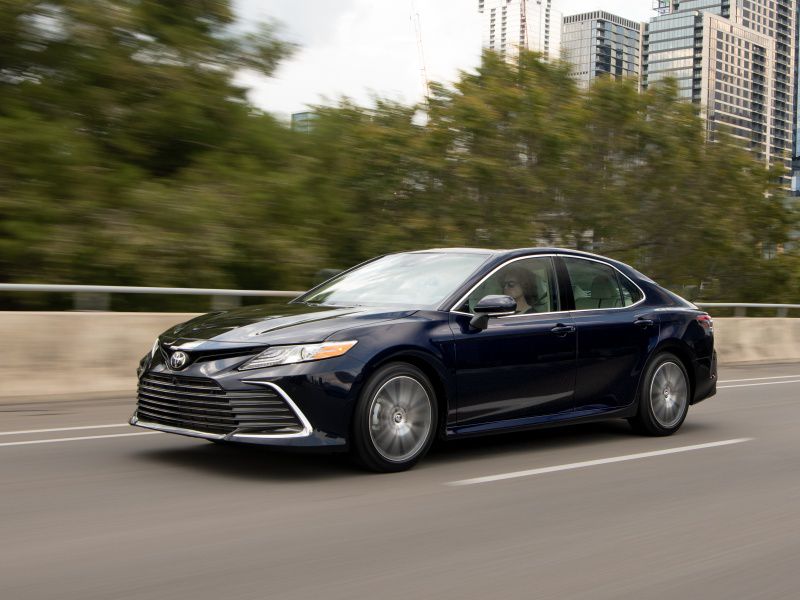
Photo by Toyota
Driving Impressions
As you’d guess, the driving manners of both the Malibu and Camry are very dependent upon the associated powertrain. In general, the low-level and mid-level Malibu and Camry provide good driving experiences with reasonable acceleration. Their suspensions are tuned for comfortable ride quality instead of sharp handling. They aren’t intended to provide much in the way of driving thrills, instead concentrating on providing solid transportation for up to five occupants. The exception is Camry TRD, which combines the 301-horsepower V-6 engine with a revised suspension that features front strut tower bracing and other tweaks. It is the most fun-to-drive of the Camry and Malibus. The sportiest of the Malibus — the RS — concentrates on looking like a performance car, but it lacks the 250-horsepower turbo engine of the Premier and its 9-speed automatic, which would give it much-needed zing. Toyota’s all-wheel-drive system is available as a standalone option for many of the 4-cylinder-equipped Camrys. It not only offers more peace of mind in inclement weather, but it also improves dry-road handling.
: Toyota Camry
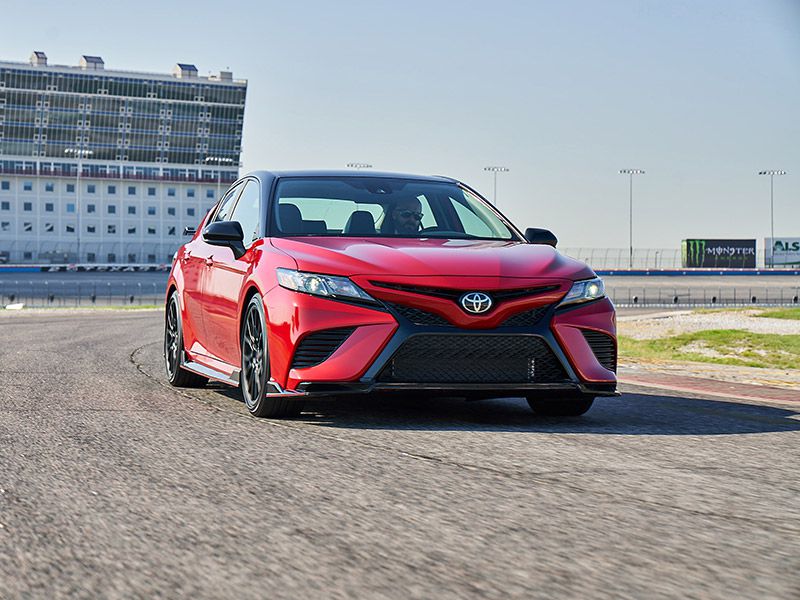
Photo by Toyota
Safety & Driver Aids
The Chevrolet Malibu and the Toyota Camry offer arrays of electronic safety equipment and driver’s aids. The Camry is equipped with Toyota Safety Sense 2.5+. One of the most inclusive and impressive of the industry’s safety systems, the version available on most Camry models includes pre-collision system with pedestrian detection, full-speed adaptive cruise control with stop and go, lane departure alert, and lane-keeping assist. It also has automatic high-beam headlights, rear seat reminder, and road sign assist. Beyond TSS 2.5+, blind-spot warning, and rear cross-traffic alert are very widely available across the Camry trims.
Many of the Chevy Malibu’s electronic safety systems are contained in optional packages. The Driver Confidence I package available on all trims but the Premier includes rear park assist, lane change alert with side blind zone alert, and rear cross-traffic alert. The more sophisticated Driver Confidence I & II package also available on LS, RS and LT includes the just-listed technologies plus automatic headlights, lane-keeping assist, lane-departure warning, following distance indicator, forward collision alert, and automatic emergency braking with pedestrian detection. Those seeking the broadest-based safety tech will want the Enhanced Driver Confidence package available on the Premier. It adds adaptive cruise control, automatic parking assist, enhanced automatic emergency braking, and electronic parking brake.
: Toyota Camry

Photo by Toyota
Interior Space & Cargo Room
Mid-size sedans are not as roomy and versatile as crossover SUVs, but they typically have no difficulty transporting five people and associated gear. That’s certainly true of both Chevrolet Malibu and Toyota Camry. Plus, their lockable trunks offer out-of-sight cargo-carrying ability that the typical crossover lacks. The Camry and Malibu both offer very pleasant accommodations for driver and front-seat passenger, and three adults can be very comfortable in the wide rear bench seats in both sedans. The Malibu offers 102.9 cubic feet of passenger volume and has a 15.7 cubic-foot trunk. The Camry has 100.4 cubic feet of passenger volume and a 15.1 cubic-foot trunk. Both sedans have 60/40 split fold-down rear seats that expand the luggage area.
: Chevrolet Malibu
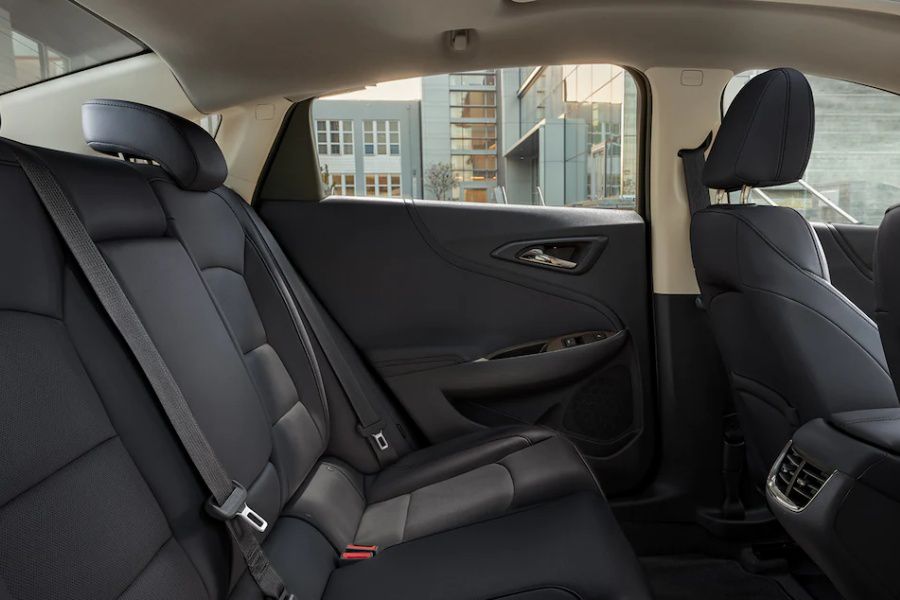
Photo by Chevrolet
Fuel Economy
Recent technology has improved the fuel economy of relatively large sedans like the Toyota Camry and Chevrolet Malibu. According to the Environmental Protection Agency, a Malibu with the base 1.5-liter turbocharged 4-cylinder engine delivers an estimated 29 mpg city driving and 36 mpg highway. With the 2.0-liter turbocharged 4-cylinder in the Premier trim fuel economy dips to 22 mpg city and 33 mpg highway. The base-level Toyota Camry LE with its naturally aspirated 4-cylinder engine delivers an estimated 28 mpg during city driving and 39 mpg on the highway. A Camry with the V-6 engine has EPA fuel economy ratings of 22 mpg city and 32 mpg highway. The most fuel-efficient Camry Hybrid offers 51 mpg city and 53 mpg highway, and as a plus, it offers more horsepower than the Malibu’s standard powertrain.
: Toyota Camry
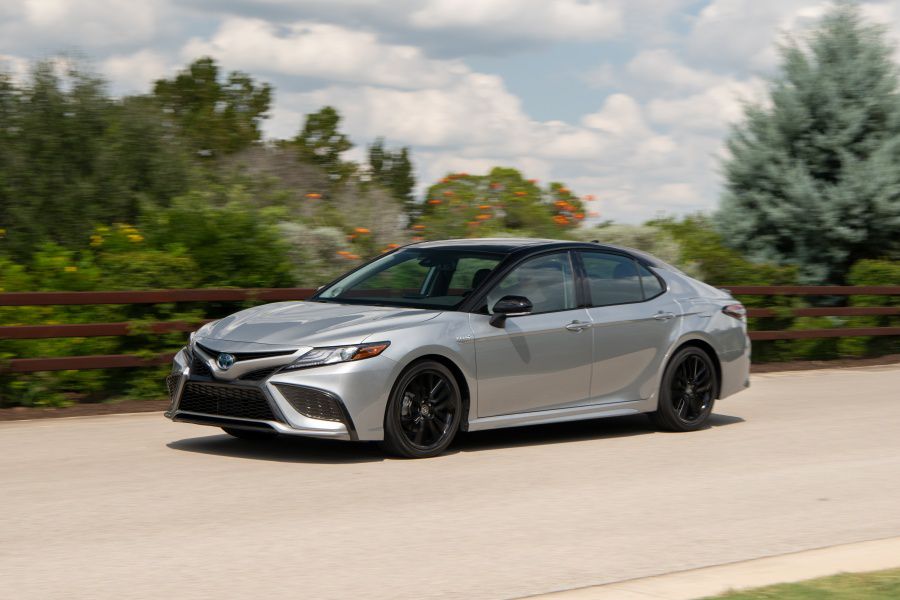
Photo by Toyota
Trim Levels
The Toyota Camry offers more trim levels and choices, while the Chevrolet Malibu’s offerings are easier to understand. The 2022 Chevrolet Malibu is available in four trims: LS, RS, LT, and Premier. The LS, RS, and LT are powered by a 1.5-liter turbocharged 4-cylinder, while the Premier uses a 2.0-liter turbo 4-cylinder with significantly more power. An 8-inch color touchscreen infotainment system is standard across the 2022 Malibu lineup and all models feature wireless Apple CarPlay and wireless Android Auto. The conventionally-powered Camry is available in 13 different configurations. There are three V6 grades – XLE, XSE and TRD; five 4-cylinder FWD grades – LE, XLE, SE, SE Nightshade, XSE; and five 4-cylinder AWD grades – LE, XLE, SE, SE Nightshade, XSE. Then there are the four Camry hybrid trims —LE, XLE, SE, and XSE. Obviously, there are plenty of choices, but with all-wheel-drive widely available, the Camry has the edge.
: Toyota Camry

Photo by Toyota
Pricing & Value
Both the Toyota Camry and Chevrolet Malibu offer that old cliche — "a lot of car for the money." The least expensive versions of both cars deliver good ride quality, impressive fuel economy, and reputations for reliability for prices in the mid-$20,000 range. The least expensive Malibu, the LS, has a suggested starting retail price below $25,000. The least expensive Camry, the LE, starts about $300 over the $25,000 mark. The top-of-the-line Malibu Premier has an MSRP under $35,000. The highest-priced conventionally powered Camry, the XSE V6, has a suggested starting price of around $37,000. The most expensive Camry hybrid lists for less than $34,000. In the red-hot competition of the American market, the Camry and Malibu pricing is very similar. In terms of resale value, the nod typically goes to the Camrys.
: Toyota Camry
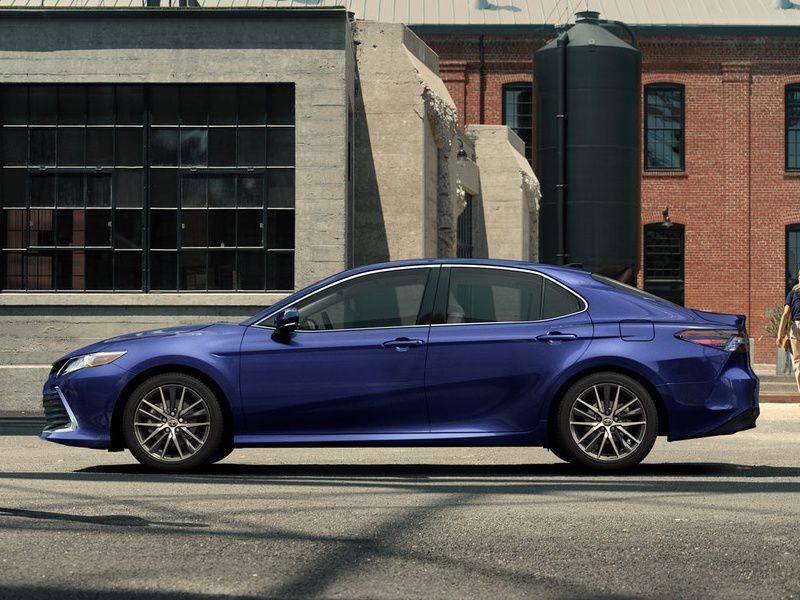
Photo by Toyota